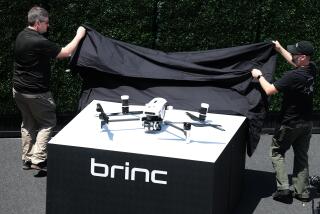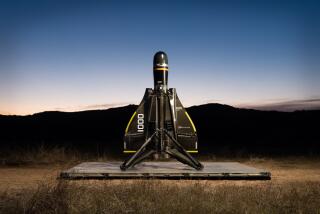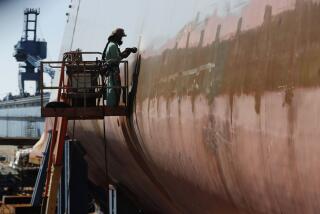New Northrop Grumman drones to begin taking over 50-year-old Navy ocean surveillance plane mission
- Share via
Reporting from Palmdale — A high-flying drone equipped with surveillance sensors and a wingspan longer than that of a Boeing 737 will be the newest way for the U.S. Navy to monitor the seas.
The first operational MQ-4C Triton drone will be delivered by Northrop Grumman Corp. to the Navy within the next week at Point Mugu Naval Air Station near Oxnard, with a second drone to follow by the end of the year. The two drones will undergo testing at Point Mugu before being deployed to Guam next year.
For the record:
8:45 a.m. Oct. 31, 2017A previous version of a photo caption said the first Northrop Grumman MQ-4C Triton drone took its first flight on Oct. 6. It was the first operational Triton drone.
The program has strong California roots — engineering and design is done in Rancho Bernardo, and the drone is assembled in Palmdale. During low-rate initial production, that line will churn out three Tritons a year.
Eventually, the Navy will have 68 of the drones, a lucrative production cycle that analysts said will help defense giant Northrop Grumman maintain its knowledge of high-altitude, long-endurance drones and keep its Palmdale production line up and running.
The Triton contract, which also includes two developmental aircraft, is “really important” not only for Northrop’s technological expertise but also for generating revenue, said Phil Finnegan, director of corporate analysis at Teal Group, an aerospace and defense market research firm.
Total program costs for Triton were estimated at $16.8 billion as of December 2016, according to a Department of Defense report released in July. That number was an almost 17% increase from an estimate a year earlier, a jump the report attributed to modernization efforts.
Triton, together with the P-8 Poseidon jet, are intended to replace the propeller-driven P-3C Orion, which has patrolled the sea for the Navy since the early 1960s, and the EP-3E Aries II aircraft. The drone will assume the intelligence, surveillance and reconnaissance duties, while the P-8 Poseidon will focus on anti-submarine warfare.
The Navy has emphasized that the manned and unmanned aircraft will cooperate. In a statement, the service said Triton’s endurance, which is listed at more than 24 hours, would allow it to keep “constant watch” over the ocean surface and “augment” the P-8’s ability to detect surface ships and submarines.
An upgraded version of the drone with enhanced intelligence capabilities will be available by 2020, and the program is expected to enter full-rate production in 2021.
“It’s a 24-hour unblinking eye in the sky,” said Doug Shaffer, vice president and program manager for Triton at Northrop.
Triton is part of Northrop’s Global Hawk family. It is produced on the same line and looks nearly identical to the high-altitude surveillance and reconnaissance drone that has been used by the U.S. Air Force in Libya, Afghanistan and Iraq.
Both drones have wingspans of 130.9 feet and a length of 47.6 feet. Their control systems are described as “man on the loop,” in which human operators at ground stations simply punch in waypoints and mission plans for the drone to follow. Those operators can monitor data the drones send back and instruct them to return to the base.
But there are a few key differences. Triton has been optimized for the inclement weather it could face while soaring above the oceans, with lightning protection strips on the nose and elsewhere on the aircraft, heater blankets on the edges of the wings and de-icing systems on the engine inlet.
This drone will also be able to perform a so-called dip maneuver, a Navy request that will allow the aircraft to descend through clouds from its highest altitude of about 55,000 feet to a lower level to take a closer look.
Some of the drone’s sensors are also specific to its mission.
On a recent weekday at Northrop’s Palmdale facility, the first two operational Tritons were geared up in a hangar, with one going through systems checks. A yellow covering protected the radar at the bottom of the aircraft, which can rotate 360 degrees to identify ships based on a number of factors, including length.
Just below the aircraft’s nose is a ball-shaped imaging sensor that can capture images and video, even at night. Data are primarily transmitted on a wideband satellite communications link.
Analysts say Triton has benefited from the lessons Northrop learned during Global Hawk’s development and production, when the program was slammed for high costs and issues with flight reliability. Analysts said concerns about Global Hawk’s price tag have receded over the last few years as operating costs decreased with greater usage.
But there have been a few hiccups during development.
In 2013, after delays and cost overruns, the Navy ordered that work be stopped on Triton’s air-to-air radar subsystem, which was intended to help the drone sense and avoid other aircraft. Shaffer said that radar has been replaced, for now, with a traffic alert and collision avoidance system, which is a transponder system that’s on most standard aircraft.
Northrop plans to add the sense-and-avoid radar in a future upgrade, he said.
Last year, Bloomberg reported that the Pentagon had flagged manufacturing flaws in Triton’s wings as early as 2013. Shaffer said the company worked with subcontractor Triumph Aerostructures, which builds the wing in Texas, to fix that issue.
Analysts said Triton’s maritime focus gives it strong export potential, especially in the Asia-Pacific region. Already, Australia has indicated its interest in purchasing at least six aircraft, Shaffer said.
Twitter: @smasunaga
ALSO
Saudi Arabia to invest $1 billion in Virgin Galactic
Mojave’s thriving aerospace community spawns home-built airplane hobbyists
Trump OKs test program to expand domestic drone flights
More to Read
Inside the business of entertainment
The Wide Shot brings you news, analysis and insights on everything from streaming wars to production — and what it all means for the future.
You may occasionally receive promotional content from the Los Angeles Times.











